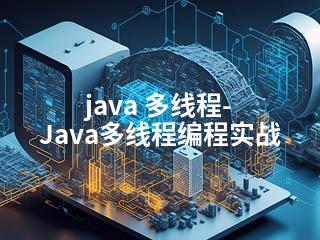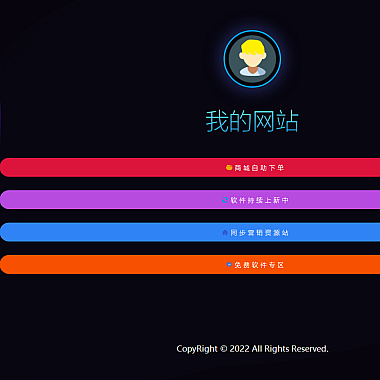java 多线程-Java多线程编程实战
Java多线程编程实战是一本介绍Java多线程编程的实践性书籍,对于想要深入了解Java多线程编程的开发者来说,这本书是一个非常好的选择。从多个方面对Java多线程编程实战进行。
基础知识
Java多线程编程实战Java多线程编程的基础知识,如线程的创建、启动、暂停、恢复和停止等。其中,线程的创建是多线程编程的步,可以通过继承Thread类或实现Runnable接口来创建线程。例如:
// 继承Thread类
public class MyThread extends Thread {
@Override
public void run() {
// 线程执行的代码
}
// 实现Runnable接口
public class MyRunnable implements Runnable {
@Override
public void run() {
// 线程执行的代码
}
线程同步
在多线程编程中,线程同步是一个非常重要的概念,它可以避免多个线程同时访问共享资源时出现的问题。Java多线程编程实战多种线程同步的方法,如synchronized关键字、Lock接口、Semaphore类、CountDownLatch类等。例如:
// 使用synchronized关键字实现线程同步
public synchronized void method() {
// 线程执行的代码
// 使用Lock接口实现线程同步
private Lock lock = new ReentrantLock();
public void method() {
lock.lock();
try {
// 线程执行的代码
} finally {
lock.unlock();
}
// 使用Semaphore类实现线程同步
private Semaphore semaphore = new Semaphore(1);
public void method() {
try {
semaphore.acquire();
// 线程执行的代码
} catch (InterruptedException e) {
e.printStackTrace();
} finally {
semaphore.release();
}
// 使用CountDownLatch类实现线程同步
private CountDownLatch countDownLatch = new CountDownLatch(1);
public void method() {
try {
countDownLatch.await();
// 线程执行的代码
} catch (InterruptedException e) {
e.printStackTrace();
}
线程池
线程池是一种管理线程的机制,可以避免线程频繁创建和销毁的开销,提高应用程序的性能。Java多线程编程实战Java中的线程池实现,如ThreadPoolExecutor类和ScheduledThreadPoolExecutor类。例如:
// 使用ThreadPoolExecutor类创建线程池
ExecutorService executorService = new ThreadPoolExecutor(5, 10, 60, TimeUnit.SECONDS, new ArrayBlockingQueue(100));
executorService.execute(() -> {
// 线程执行的代码
});
// 使用ScheduledThreadPoolExecutor类创建定时任务线程池
ScheduledExecutorService scheduledExecutorService = new ScheduledThreadPoolExecutor(5);
scheduledExecutorService.schedule(() -> {
// 定时任务执行的代码
}, 10, TimeUnit.SECONDS);
线程安全
线程安全是指多个线程同时访问共享资源时,不会出现数据不一致或者程序崩溃的问题。Java多线程编程实战多种线程安全的方法,如使用线程安全的集合类、使用volatile关键字、使用Atomic类等。例如:
// 使用线程安全的集合类实现线程安全
List list = Collections.synchronizedList(new ArrayList());
list.add("hello");
// 使用volatile关键字实现线程安全
private volatile boolean flag = false;
public void method() {
flag = true;
// 使用Atomic类实现线程安全
private AtomicInteger atomicInteger = new AtomicInteger();
public void method() {
int result = atomicInteger.incrementAndGet();
线程调试
在多线程编程中,线程调试是一个非常困难的问题。Java多线程编程实战多种线程调试的方法,如使用jstack命令、使用jvisualvm工具、使用Java Flight Recorder等。例如:
// 使用jstack命令查看线程状态
jstack pid
// 使用jvisualvm工具查看线程状态
jvisualvm
// 使用Java Flight Recorder查看线程状态
jcmd pid JFR.start
线程性能
线程性能是指多线程程序的执行效率和资源利用率。Java多线程编程实战多种线程性能的优化方法,如使用线程池、使用ThreadLocal类、使用分离锁等。例如:
// 使用ThreadLocal类实现线程局部变量
private static ThreadLocal threadLocal = ThreadLocal.withInitial(() -> new SimpleDateFormat("yyyy-MM-dd"));
public static Date parse(String dateStr) throws ParseException {
SimpleDateFormat sdf = threadLocal.get();
return sdf.parse(dateStr);
// 使用分离锁实现线程性能优化
private final Object readLock = new Object();
private final Object writeLock = new Object();
public void read() {
synchronized (readLock) {
// 读取操作
}
public void write() {
synchronized (writeLock) {
// 写入操作
}
线程并发
线程并发是指多个线程同时执行任务的能力。Java多线程编程实战多种线程并发的方法,如使用CompletableFuture类、使用ForkJoinPool类、使用Parallel Streams等。例如:
// 使用CompletableFuture类实现线程并发
CompletableFuture.supplyAsync(() -> {
// 线程执行的代码
}).thenAccept(result -> {
// 回调函数
});
// 使用ForkJoinPool类实现线程并发
ForkJoinPool forkJoinPool = new ForkJoinPool();
forkJoinPool.submit(() -> {
// 线程执行的代码
});
// 使用Parallel Streams实现线程并发
List list = Arrays.asList(1, 2, 3, 4, 5);
list.parallelStream().forEach(item -> {
// 线程执行的代码
});
线程异常
线程异常是指多线程程序中出现的异常情况。Java多线程编程实战多种线程异常的处理方法,如使用UncaughtExceptionHandler接口、使用try-catch语句、使用Future类等。例如:
// 使用UncaughtExceptionHandler接口处理线程异常
Thread.setDefaultUncaughtExceptionHandler((thread, throwable) -> {
// 异常处理代码
});
// 使用try-catch语句处理线程异常
try {
// 线程执行的代码
} catch (Exception e) {
// 异常处理代码
// 使用Future类处理线程异常
ExecutorService executorService = Executors.newSingleThreadExecutor();
Future future = executorService.submit(() -> {
// 线程执行的代码
return 1;
});
try {
int result = future.get();
} catch (InterruptedException | ExecutionException e) {
// 异常处理代码
线程死锁
线程死锁是指多个线程互相等待对方释放资源而无法继续执行的情况。Java多线程编程实战多种线程死锁的解决方法,如使用避免死锁的算法、使用死锁检测工具等。例如:
// 使用避免死锁的算法解决线程死锁
public void transfer(Account from, Account to, int amount) {
while (true) {
if (from.lock.tryLock()) {
if (to.lock.tryLock()) {
try {
from.withdraw(amount);
to.deposit(amount);
break;
} finally {
to.lock.unlock();
}
} else {
from.lock.unlock();
}
}
}
// 使用死锁检测工具解决线程死锁
jstack -l pid
jconsole
线程通信
线程通信是指多个线程之间通过共享内存或消息传递来实现协作的过程。Java多线程编程实战多种线程通信的方法,如使用wait()、notify()、notifyAll()方法、使用BlockingQueue接口、使用Semaphore类等。例如:
// 使用wait()、notify()、notifyAll()方法实现线程通信
public class MyQueue {
private final Object lock = new Object();
private Queue queue = new LinkedList();
public void put(String str) {
synchronized (lock) {
queue.offer(str);
lock.notifyAll();
}
}
public String take() throws InterruptedException {
synchronized (lock) {
while (queue.isEmpty()) {
lock.wait();
}
return queue.poll();
}
}
// 使用BlockingQueue接口实现线程通信
BlockingQueue blockingQueue = new ArrayBlockingQueue(100);
blockingQueue.put("hello");
String str = blockingQueue.take();
// 使用Semaphore类实现线程通信
Semaphore semaphore = new Semaphore(0);
semaphore.release();
semaphore.acquire();
Java多线程编程实战是一本非常实用的书籍,对于想要深入了解Java多线程编程的开发者来说,是一个非常好的选择。从多个方面对Java多线程编程实战进行了,希望能够对读者有所帮助。







